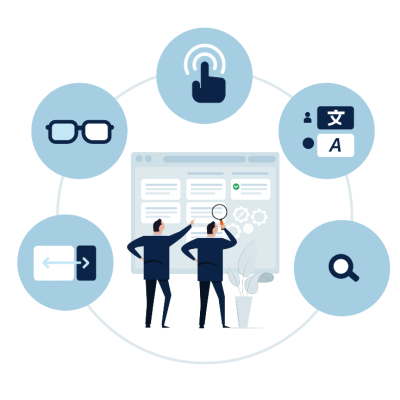What is web accessibility?
Put simply, web accessibility means ensuring that websites or mobile apps are usable by as many people as possible. This includes those with vision or hearing impairments, motor difficulties, and cognitive impairments or learning disabilities.
Accessibility also refers to making websites and apps usable for people with more situational limitations, such as people using mobile phones, older people, people in locations where they cannot play sound, people with ‘temporary disabilities’ such as injuries or lost glasses, or people with socio-economic limitations such as slow Internet connection.
Why is accessibility important?
Accessibility is important for ensuring that everyone has equal access to information online. It aims to remove barriers for users with disabilities and impairments who might otherwise struggle to access online content. Around twenty percent of the UK population have a long term illness, impairment or disability.
Accessibility is particularly important for public sector websites and apps, because they often provide essential services that everyone must be able to access.
On top of this, making your website or app accessible is beneficial to every user. Accessible websites are often faster, clearer, have better user journeys, and could rank higher on search engine results.
Meeting accessibility requirements
All public sector bodies have to meet the accessibility regulations that came into force in 2018, unless they are exempt or partially exempt (such as schools).
These requirements outline the need for websites and apps to be ‘perceivable, operable, understandable, and robust’ for as many people as possible.
Non-public sector organisations and businesses are not required by law to reach these same accessibility standards for their websites. However, there are numerous benefits of making websites as accessible as possible:
- User-friendly: adhering to web accessibility practices makes your website and content easier to understand for all visitors. Overall, your user experience will improve across a variety of situations, for different devices, and for all users including older users or those with disabilities.
- Having an accessible website shows your organisation’s commitment to inclusivity, improving your relationship with the individual site user.
- Following good accessibility practices will help your website appear higher up on search engine rankings.
Making your website accessible
There are many ways to make your website accessible, some are more simple than others.
For a thorough look at what can be done, designers and developers refer to the Web Content Accessibility Guidelines (WCAG). It is usually more effective to incorporate accessibility from the start of a project, rather than returning to re-do work.
If these guidelines seem a lot to take in… hear from one of our designers, Alice, for simple ways to make your website accessible.
Got questions about the accessibility of your website or app? Don’t hesitate to get in touch.
Example websites
The Children’s Commissioner for England
Our recent launch of the new website for the Children’s Commissioner had to meet the WCAG AA Standard. The website audience is diverse, aimed at children and young people as well as teachers, parents and the media. Combining three priority areas identified by the Commissioner into one comprehensive website, it was vital that all of the detailed reports, articles and publications are easy to read and view across multiple devices, platforms and screen readers.
Green Suffolk
We worked with Suffolk County Council to create a new website promoting Suffolk as the ‘Greenest County’. With a wealth of content (totaling over 300 pages), the website needed to meet accessibility guidelines to ensure that everyone is able to read about their inspirational work. Check out their website: greensuffolk.org



